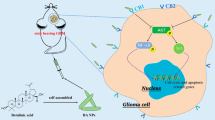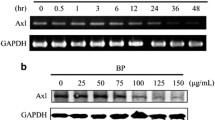Abstract
Among gliomas types, glioblastoma is considered the most malignant and the worst form of primary brain tumor. It is characterized by high infiltration rate and great angiogenic capacity. The presence of an inflammatory microenvironment contributes to chemo/radioresistance, resulting in poor prognosis for patients. Recent data show that thiazolidinones have a wide range of pharmacological properties, including anti-inflammatory and antiglioma activities. Nanocapsules of biodegradable polymers become an alternative to cancer treatment since they provide targeted drug delivery and could overcome blood–brain barrier. Therefore, here we investigated the in vitro antiglioma activity and the potential in vivo toxicity of 2- (2-methoxyphenyl) -3- ((piperidin-1-yl) ethyl) thiazolidin-4-one-loaded polymeric nanocapsules (4L-N). Nanocapsules were prepared and characterized in terms of particle size, polydispersity index, zeta potential, pH, molecule content and encapsulation efficiency. Treatment with 4L-N selectively decreased human U138MG and rat C6 cell lines viability and proliferation, being even more efficient than the free-form molecule (4L). In addition, 4L-N did not promote toxicity to primary astrocytes. We further demonstrated that the treatment with sub-therapeutic dose of 4L-N did not alter weight, neither resulted in mortality, toxicity or peripheral damage to Wistar rats. Finally, 4L as well as 4L-N did not alter makers of oxidative damage, such as TBARS levels and total sulfhydryl content, and did not change antioxidant enzymes SOD and CAT activity in liver and brain of treated rats. Taken together, these data indicate that the nanoencapsulation of 4L has potentiated its antiglioma effect and does not cause in vivo toxicity.
Graphical Abstract










Similar content being viewed by others
References
Abdelazeem AH, Gouda AM, Omar HA, Tolba MF (2014) Design, synthesis and biological evaluation of novel diphenylthiazole-based cyclooxygenase inhibitors as potential anticancer agents. Bioorg Chem 57:132–141
Aebi H (1984) Catalase in vitro. Methods Enzymol 105:121–126
Aksenov MY, Markesbery WR (2001) Changes in thiol content and expression of glutathione redox system genes in the hippocampus and cerebellum in Alzheimer’s disease. Neurosci Lett 302:141–145. https://doi.org/10.1016/S0304-3940(01)01636-6
Almeida JS, Lima F, Ros SD et al (2010) Nanostructured systems containing rutin: in vitro antioxidant activity and photostability studies. Nanoscale Res Lett 5(10):1603–1610
Borisov KE, Sakaeva DD (2015) The immunosuppressive microenvironment of malignant gliomas. Arkh Patol 77:54–63
Chandrappa S, Kavitha CV, Shahabuddin MS, Vinaya K, Kumar CA, Ranganatha SR, Rangappa KS (2009) Synthesis of 2-(5-((5-(4-chlorophenyl) furan-2-yl) methylene)-4-oxo-2-thioxothiazolidin-3-yl) acetic acid derivatives and evaluation of their cytotoxicity and induction of apoptosis in human leukemia cells. Bioorg Med Chem 17(6):2576–2584
Chari RV (2007) Targeted cancer therapy: conferring specificity to cytotoxic drugs. Acc Chem Res 41(1):98–107
Chassot JM, Ribas D, Silveira EF, Grünspan LD, Pires CC, Farago PV, Cruz L (2015) Beclomethasone dipropionate-loaded polymeric nanocapsules: development, in vitro cytotoxicity, and in vivo evaluation of acute lung injury. J Nanosci Nanotechnol 15(1):855–864
Chen S, Chen L, Le NT, Zhao C, Sidduri A, Lou JP, Konzelmann F (2007) Synthesis and activity of quinolinyl-methylene-thiazolinones as potent and selective cyclin-dependent kinase 1 inhibitors. Bioorg Med Chem Lett 17(8):2134–2138
Chumak VV, Fil MR, Panchuk RR, Zimenkovsky BS, Havrylyuk DY, Lesyk RB et al (2014a) Study of antineoplastic action of novel isomeric derivatives of 4-thiazolidinone. Ukr Biochem J 86:96–105
Chumak VV, Fil МR, Panchuk RR, Zimenkovsky BS, Havrylyuk DY, Lesyk RB, Stoika RS (2014b) Study of antineoplastic action of novel isomeric derivatives of 4-thiazolidinone. Ukrainian Biochem J 86(6):96–105
da Silveira EF et al (2013) Ketoprofen-loaded polymeric nanocapsules selectively inhibit cancer cell growth in vitro and in preclinical model of glioblastoma multiforme. Invest New Drugs 31(6):1424–1435
da Silveira EF et al (2017) Synthetic 2-aryl-3-((piperidin-1-yl)ethyl)thiazolidin-4-ones exhibit selective in vitro antitumoral activity and inhibit cancer cell growth in a preclinical model of glioblastoma multiforme. Chem-Bio Int 266:1–9
Deep A, Jain S, Sharma PC, Phogat P, Malhotra M (2012) Synthesis of 2-(aryl)-5-(arylidene)-4-thiazolidinone derivatives with potential analgesic and anti-inflammatory activity. Med Chem Res 21(8):1652–1659
Degterev A, Lugovskoy A, Cardone M, Mulley B, Wagner G, Mitchison T, Yuan J (2001) Identification of small-molecule inhibitors of interaction between the BH3 domain and Bcl-x L. Nat Cell Biol 3(2):173
Dong Fangyuan et al (2016) Doxorubicin-loaded biodegradable self-assembly zein nanoparticle and its anti-cancer effect: preparation, in vitro evaluation, and cellular uptake. Colloids Surf B 140:324–331
Dunn GP, Dunn IF, Curry WT (2007) Prognostic significance of tumor infiltrating lymphocytes in human glioma. Cancer Immun 7:12–28
Esterbauer H, Cheeseman KH (1990) Determination of aldehydic lipid peroxidation products: malonaldehyde and 4-hydroxynonenal. Methods Enzymol 186:407–421
Fontana MC, Coradini K, Guterres SS et al (2009) Nanoencapsulation as a way to control the release and to increase the photostability of clobetasol propionate: influence of the nanostructured system. J Biomed Nanotechnol 5(3):254–263
Friedrich RB, Fontana MC, Beck RCR et al (2008) Development and physicochemical characterization of dexamethasone-loaded polymeric nanocapsule suspensions. Quim Nova 31:1131–1136
Gonsette RE (2008) Neurodegeneration in multiple sclerosis: the role of oxidative stress and excitotoxicity. J Neurol Sci 274(1):48–53
Havrylyuk D, Zimenkovsky B, Vasylenko O, Zaprutko L, Gzella A, Lesyk R (2009) Synthesis of novel thiazolone-based compounds containing pyrazoline moiety and evaluation of their anticâncer activity. Eur J Med Chem 44:1396–1404
Holland EC (2001) Progenitor cells and glioma formation. Curr Opin Neurol 14(6):683–688
Jung KY, Samadani R, Chauhan J, Nevels K, Yap JL, Zhang J, Shukla S (2013) Structural modifications of (Z)-3-(2-aminoethyl)-5-(4-ethoxybenzylidene) thiazolidine-2, 4-dione that improve selectivity for inhibiting the proliferation of melanoma cells containing active ERK signaling. Org Biomol Chem 11(22):3706–3732
Khachane P, Nagarsenker MS (2011a) Positively charged polymeric nanoparticles: application in improving therapeutic efficacy of meloxicam after oral administration. Die Pharmazie-Int J Pharm Sci 66(5):334–338
Khachane Parag, Nagarsenker Mangal S (2011b) Eudragit EPO nanoparticles: application in improving therapeutic efficacy and reducing ulcerogenicity of meloxicam on oral administration. J Biomed Nanotechnol 7(4):590–597
Коbylinska LI, Boiko NM, Panchuk RR, Grytsyna II, Biletska LP, Lesyk RB, Stoika RS (2016) Putative anticancer potential of novel 4-thiazolidinone derivatives: cytotoxicity toward rat C6 glioma in vitro and correlation of general toxicity with the balance of free radical oxidation in rats. Croat Med J 57(2):151–161
Kunzler A, Neuenfeldt PD, Das Neves AM, Pereira Claudio MP, Marques GH, Nascente PS, Fernandes MHV, Hubner SO, Cunico W (2013) Synthesis, antifungal and cytotoxic activities of 2-aryl-3-((piperidin-1-yl)ethyl)thiazolidinones. Eur J Med Chem 64:74–80
Lesyk RB, Zimenkovsky BS (2004) 4-Thiazolidones: centenarian history, current status and perspectives for modern and organic and medicial chemistry. Curr Org Chem 8(16):1547–1577
Li W, Wang Z, Gududuru V, Zbytek B, Slominski AT, Dalton JT, Miller DD (2007) Structure-activity relationship studies of arylthiazolidine amides as selective cytotoxic agents for melanoma. Anticancer Res 27(2):883–888
Ljubisavljevic S (2016) Oxidative stress and neurobiology of demyelination. Mol Neurobiol 53(1):744–758
Louis DN, Ohgaki H, Wiestler OD, Cavenee WK, Burger PC, Jouvet A, Scheithauer BW, Kleihues P (2007) The 2007 WHO classification of tumours of the central nervous system. Acta Neuropathol 114(5):547
Lowry OH, Rosebrough NJ, Farr AL, Randall RJ (1951) Protein measurement with the Folin phenol reagent. J Biol Chem 193:265–275
Lugovskoy AA, Degterev AI, Fahmy AF, Zhou P, Gross JD, Yuan J, Wagner G (2002) A novel approach for characterizing protein ligand complexes: molecular basis for specificity of small-molecule Bcl-2 inhibitors. J Am Chem Soc 124(7):1234–1240
Maji R, Dey NS, Satapathy BS, Mukherjee B, Mondal S (2015) Preparation and characterization of tamoxifen citrate loaded nanoparticles for breast cancer therapy. Int J Nanomed 9:3107–3118
Misra HP, Fridovich I (1972) The role of superoxide anion in the autoxidation of epinephrine and a simple assay for superoxide dismutase. J Biol Chem 247:3170–3175
Moorkoth S (2015) Synthesis and anti-cancer activity of novel thiazolidinone analogs of 6-aminoflavone. Chem Pharm Bull 63(12):974–985
Mrugala MM (2013) Advances and challenges in the treatment of glioblastoma: a clinician’s perspective. Discov Med 15(83):221–230
Obermeier B, Daneman R, Ransohoff RM (2013) Development, maintenance and disruption of the blood-brain barrier. Nat Med 19:1584–1596
Onen-Bayram FE, Durmaz I, Scherman D, Herscovici J, Cetin-Atalay R (2012) A novel thiazolidine compound induces caspase-9 dependent apoptosis in cancer cells. Bioorg Med Chem 20(17):5094–5102
Ourique AF, Pohlmann AR, Guterres SS et al (2008) Tretinoin-loaded nanocapsules: preparation, physicochemical characterization, and photostability study. Int J Pharm 352(1–2):1–4
Patel D, Kumari P, Patel N (2012) Synthesis and biological evaluation of some thiazolidinones as antimicrobial agents. Eur J Med Chem 48:354–362
Pohlmann AR, Fonseca FN, Paese K et al (2013) Poly(-caprolactone) microcapsules and nanocapsules in drug delivery. Expert Opin Drug Deliv. 10(5):623–638
Santos SS, Lorenzoni A, Pegoraro NS, Denardi LB, Alves SH, Schaffazick SR, Cruz L (2014) Formulation and in vitro evaluation of coconut oil-core cationic nanocapsules intended for vaginal delivery of clotrimazole. Colloids Surf B 116:270–276
Saundane AR, Yarlakatti M, Walmik P, Katkar V (2012) Synthesis, antioxidant and antimicrobial evaluation of thiazolidinone, azetidinone encompassing indolylthienopyrimidines. J Chem Sci 124(2):469–481
Senkiv J, Finiuk N, Kaminskyy D, Havrylyuk D, Wojtyra M, Kril I, Lesyk R (2016) 5-Ene-4-thiazolidinones induce apoptosis in mammalian leukemia cells. Eur J Med Chem 117:33–46
Soffietti R, Leoncini B, Ruda R (2007) New developments in the treatment of malignant gliomas. Expert Rev Neurother 7:1313–1326
Stupp R, Hegi ME, Gilbert MR, Chakravarti A (2007) Chemoradiotherapy in malignant glioma: standard of care and future directions. J Clin Oncol 25(26):4127–4136
Tripathi AC, Gupta SJ, Fatima GN, Sonar PK, Verma A, Saraf SK (2014) 4-Thiazolidinones: the advances continue. Eur J Med Chem 72:52–77
Vassilev LT, Tovar C, Chen S, Knezevic D, Zhao X, Sun H, Chen L (2006) Selective small-molecule inhibitor reveals critical mitotic functions of human CDK1. Proc Natl Acad Sci USA 103(28):10660–10665
Villalba BT et al (2016) Polymeric nanocapsules as a technological alternative to reduce the toxicity caused by meloxicam in mice. Regul Toxicol Pharmacol 81:316–321
Wan Y, Wu S, **ao G, Liu T, Hou X, Chen C, Fang H (2015) Design, synthesis and preliminary bioactivity studies of 2-thioxo-4-thiazolidinone derivatives as Bcl-2 inhibitors. Bioorg Med Chem 23(9):1994–2003
Acknowledgements
The authors thank to FAPERGS (11/2068-7; 16/2551-0000265-7) for financial support. CNPq (307330/2012-5; 310846/2014-5) is also acknowledged.
Author information
Authors and Affiliations
Contributions
EFS: Experimental design, culture preparation and treatment, discussion of results and manuscript preparation. LMF: Experimental design and preparation and characterization of nanocapsules. MG: Experimental design, preparation and characterization of nanocapsules and manuscript preparation. LC: Experimental design and preparation and characterization of nanocapsules. NSP: Experimental design, culture preparation and treatment, viability and cell proliferation assays. PTR: Culture preparation and treatment, viability and cell proliferation assays. NPB: Preparation of astrocyte cultures, treatment of cultures with nanocapsules, analysis of viability and cell proliferation data, treatment of animals in vivo and oxidative stress tests. MSPS: Preparation of astrocyte cultures, treatment of cultures with nanocapsules, analysis of viability and cell proliferation data, treatment of animals in vivo and oxidative stress tests. RR: Biochemical toxicity and data analysis. RMS: Experimental design, statistical analysis, interpretation and discussion of results and manuscript preparation. WC: Synthesis and design of thiazolidinones. FMS: Experimental design and interpretation and discussion of the oxidative stress results. JHA: Preparation of cell cultures, cell treatments, propidium iodide assay and analysis of the results. APH: Experimental design, statistical analysis, interpretation and discussion of results and manuscript preparation. EB: Experimental design, statistical analysis, interpretation and discussion of results and manuscript preparation.
Corresponding authors
Ethics declarations
Conflict of interest
All the authors declares that they have no conflict of interest.
Ethical Approval
All applicable international, national, and/or institutional guidelines for the care and use of animals were followed. All procedures used in the present study followed the Principles of Laboratory Animal Care from NIH and the Brazilian laws and were approved by the Ethical Committee of the Federal University of Pelotas (Protocol Number 9219).
Additional information
Publisher's Note
Springer Nature remains neutral with regard to jurisdictional claims in published maps and institutional affiliations.
Rights and permissions
About this article
Cite this article
da Silveira, E.F., Ferreira, L.M., Gehrcke, M. et al. 2-(2-Methoxyphenyl)-3-((Piperidin-1-yl)ethyl)thiazolidin-4-One-Loaded Polymeric Nanocapsules: In Vitro Antiglioma Activity and In Vivo Toxicity Evaluation. Cell Mol Neurobiol 39, 783–797 (2019). https://doi.org/10.1007/s10571-019-00678-4
Received:
Accepted:
Published:
Issue Date:
DOI: https://doi.org/10.1007/s10571-019-00678-4




